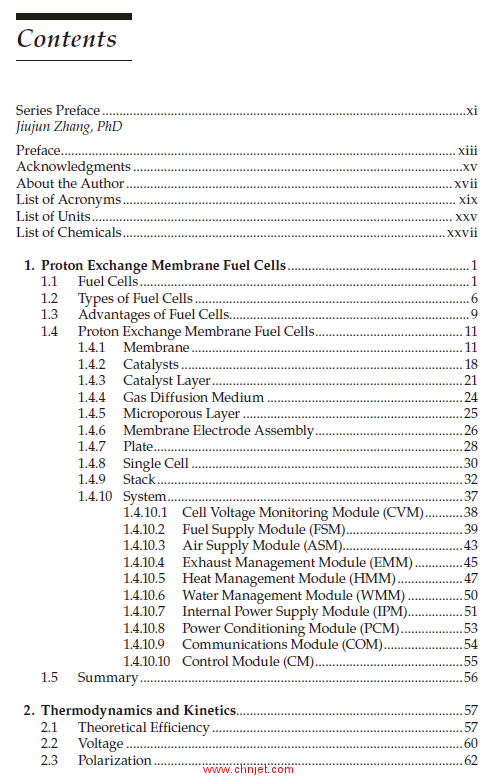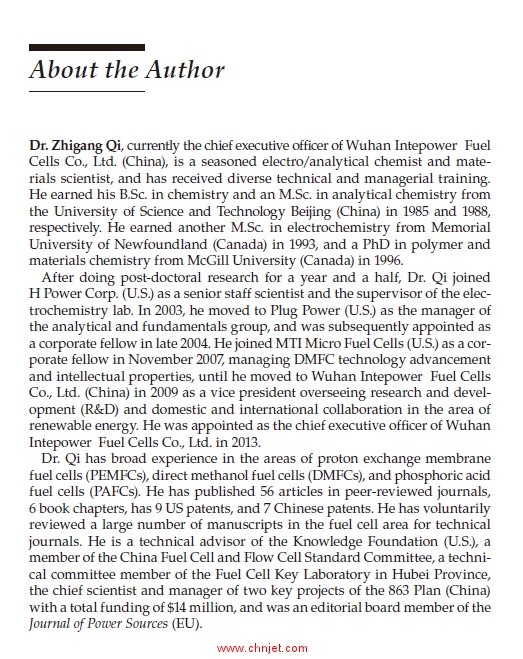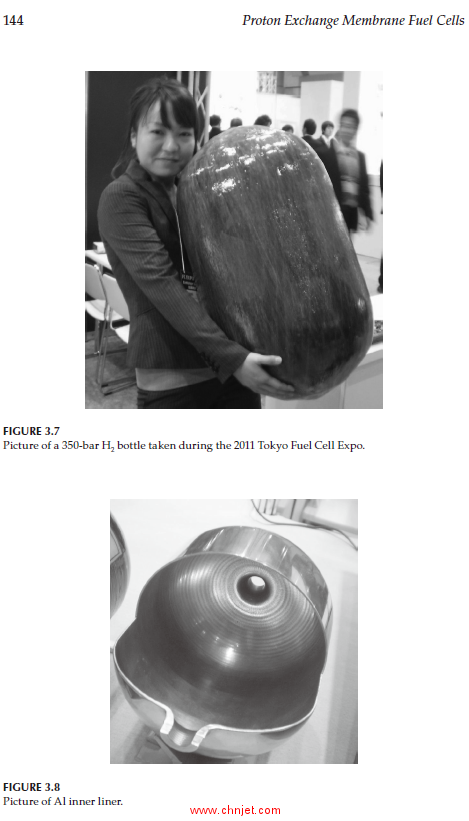马上注册,结交更多好友,享用更多功能,让你轻松玩转社区。
您需要 登录 才可以下载或查看,没有账号?立即注册


x
《Proton Exchange Membrane Fuel Cells》
质子交换膜燃料电池
作者:Zhigang Qi
Wuhan Intepower Fuel Cells Co., LtdHubei, China
出版社:CRC
出版时间:2014年
《Proton Exchange Membrane Fuel Cells》

《Proton Exchange Membrane Fuel Cells》

《Proton Exchange Membrane Fuel Cells》

《Proton Exchange Membrane Fuel Cells》

《Proton Exchange Membrane Fuel Cells》

目录
Series Preface...........................................................................................................xi
Jiujun Zhang, PhD
Preface....................................................................................................................xiii
Acknowledgments.................................................................................................xv
About the Author................................................................................................xvii
List of Acronyms..................................................................................................xix
List of Units..........................................................................................................xxv
List of Chemicals...............................................................................................xxvii
1. Proton Exchange Membrane Fuel Cells......................................................1
1.1 Fuel Cells.................................................................................................1
1.2 Types of Fuel Cells.................................................................................6
1.3 Advantages of Fuel Cells......................................................................9
1.4 Proton Exchange Membrane Fuel Cells............................................11
1.4.1 Membrane................................................................................11
1.4.2 Catalysts...................................................................................18
1.4.3 Catalyst Layer..........................................................................21
1.4.4 Gas Diffusion Medium..........................................................24
1.4.5 Microporous Layer.................................................................25
1.4.6 Membrane Electrode Assembly............................................26
1.4.7 Plate...........................................................................................28
1.4.8 Single Cell................................................................................30
1.4.9 Stack..........................................................................................32
1.4.10 System.......................................................................................37
1.4.10.1 Cell Voltage Monitoring Module (CVM)............38
1.4.10.2 Fuel Supply Module (FSM)...................................39
1.4.10.3 Air Supply Module (ASM)...................................43
1.4.10.4 Exhaust Management Module (EMM)...............45
1.4.10.5 Heat Management Module (HMM)....................47
1.4.10.6 Water Management Module (WMM).................50
1.4.10.7 Internal Power Supply Module (IPM)................51
1.4.10.8 Power Conditioning Module (PCM)...................53
1.4.10.9 Communications Module (COM)........................54
1.4.10.10 Control Module (CM)............................................55
1.5 Summary...............................................................................................56
2. Thermodynamics and Kinetics..................................................................57
2.1 Theoretical Efficiency..........................................................................57
2.2 Voltage...................................................................................................60
2.3 Polarization...........................................................................................62
vi
Contents
2.4 Tafel Equation.......................................................................................68
2.5 Voltage Loss due to H2 Crossover at an Open Circuit....................73
2.6 Example.................................................................................................75
2.7 Limiting Current Density...................................................................77
2.7.1 Diffusion..................................................................................77
2.7.2 Porous Electrode.....................................................................80
2.7.3 Flooded Electrode...................................................................82
2.7.4 Achievable Current Density and Power Density...............87
2.8 Impact of the Ionomer on the Three-Phase Boundary...................89
2.9 System Efficiency.................................................................................92
2.10 Water Balance.......................................................................................96
2.11 Thoughts on Ultra Thin Catalyst Layers..........................................99
2.12 Startup and Shutdown Strategies....................................................105
2.12.1 Impacts of OCV and Air/Fuel Boundary..........................106
2.12.2 Strategies................................................................................108
2.12.2.1 N2 Purge..................................................................108
2.12.2.2 H2 Purge.................................................................108
2.12.2.3 H2 Diffusion...........................................................109
2.12.2.4 Filling Stack Enclosure with H2..........................111
2.13 Summary.............................................................................................112
3. Hydrogen H2.................................................................................................115
3.1 Properties of H2..................................................................................115
3.2 Generation of H2.................................................................................115
3.2.1 Reforming of Hydrocarbons and Alcohols.......................116
3.2.2 Cracking of Ammonia..........................................................127
3.2.3 Electrolysis of Water.............................................................130
3.2.3.1 Efficiency................................................................130
3.2.3.2 Internal Pressurization.........................................134
3.2.3.3 Proton Onsite PEM Electrolyzer.........................136
3.2.4 Chemical Sources..................................................................138
3.2.4.1 Metals......................................................................138
3.2.4.2 Complex Metal Hydrides.....................................141
3.3 Hydrogen Storage..............................................................................143
3.3.1 Compressed Gas...................................................................143
3.3.2 Metal Hydride.......................................................................143
3.4 Hydrogen Transportation and Refueling.......................................148
3.5 Summary.............................................................................................150
4. Evaluation......................................................................................................153
4.1 Catalyst................................................................................................153
4.1.1 Composition..........................................................................153
4.1.2 Size and Size Distribution...................................................154
4.1.3 Crystallite Size.......................................................................155
vii
Contents
4.1.4 Surface Area...........................................................................155
4.1.5 Activity...................................................................................157
4.1.6 Cyclic Voltammetry..............................................................159
4.2 Membrane...........................................................................................163
4.2.1 Proton Conductivity.............................................................163
4.2.2 Water Content........................................................................165
4.2.3 Durability...............................................................................166
4.2.4 Dimensional Changes..........................................................167
4.3 GDM.....................................................................................................168
4.3.1 Electronic Conductivity.......................................................168
4.3.2 Hydrophobicity.....................................................................169
4.3.3 Porosity...................................................................................170
4.4 Plate......................................................................................................171
4.4.1 Conductivity..........................................................................171
4.4.2 Density and Permeability....................................................172
4.4.3 Corrosion Current.................................................................173
4.5 MEA.....................................................................................................175
4.5.1 Catalyst Loading...................................................................175
4.5.2 Electrochemical Active Surface Area.................................175
4.5.3 H2 Crossover..........................................................................175
4.6 Single Cell...........................................................................................177
4.6.1 V-I Curve................................................................................177
4.6.2 Durability Assessment.........................................................178
4.6.3 Load Cycling..........................................................................179
4.6.4 Temperature Cycling............................................................179
4.6.5 Poisoning Tolerance..............................................................180
4.7 Stack.....................................................................................................182
4.7.1 Performance and Durability...............................................182
4.7.2 Startup Rate and Subzero Temperature Challenge.........183
4.8 Balance of Plant..................................................................................185
4.8.1 DC–DC Converter.................................................................185
4.8.2 Air Supply Device.................................................................186
4.8.3 Liquid Pump..........................................................................187
4.8.4 Heat Exchanger.....................................................................188
4.8.5 Solenoid Valve.......................................................................190
4.8.6 Control Board........................................................................191
4.8.7 Flow Meter and Sensor........................................................191
4.8.8 Internal Power Supply..........................................................192
4.9 System..................................................................................................194
4.10 Summary.............................................................................................195
5. Stationary Power..........................................................................................197
5.1 Backup Power.....................................................................................197
5.1.1 Telecommunications Station...............................................197
5.1.2 Fuel Cell System with Air-Cooled Stack...........................200
viii Contents
5.1.2.1 System Architecture..............................................200
5.1.2.2 Fuel Cell System with Ballard FCgen-1020ACS Stack........................................................201
5.1.2.3 ReliOn Fuel Cell Systems.....................................211
5.1.3 Fuel Cell System with Liquid-Cooled Stack......................212
5.1.3.1 Features of the 5 kW System................................213
5.1.3.2 Stack from Sunrise Power....................................215
5.1.3.3 Breadboard System...............................................218
5.1.3.4 Fuel Cell System....................................................222
5.2 Primary Power....................................................................................226
5.2.1 Fuel Processing......................................................................226
5.2.1.1 Desulfurization.....................................................227
5.2.1.2 Steam Reforming...................................................228
5.2.1.3 Water–Gas Shift Reaction....................................229
5.2.1.4 Preferential Oxidation..........................................230
5.2.1.5 Steam Reforming Methanol.................................231
5.2.2 IdaTech/Ballard Systems.....................................................232
5.3 Summary.............................................................................................234
6. Motive Power................................................................................................237
6.1 Fuel Cell Vehicles...............................................................................237
6.2 Vehicle Power Requirements............................................................239
6.3 Driving Distance with 6 kg H2.........................................................244
6.4 Electrical Power Train.......................................................................250
6.5 Fuel Cell System.................................................................................254
6.6 Examples.............................................................................................260
6.6.1 Tourist Cart............................................................................260
6.6.2 Car...........................................................................................262
6.6.3 Forklift....................................................................................266
6.6.3.1 Shanghai Shenli System.......................................268
6.6.3.2 Plug Power System................................................270
6.6.4 Data of Some Fuel Cell Vehicles.........................................270
6.7 Vehicle Test Procedures.....................................................................275
6.8 Summary.............................................................................................275
7. Portable Power..............................................................................................277
7.1 Volumetric Energy Density of Various Fuels.................................277
7.2 Direct Methanol Fuel Cells...............................................................280
7.3 Conventional DMFC System Architecture.....................................283
7.4 DMFC System Using Neat Methanol by MTI Micro Fuel Cells....285
7.4.1 How to Make It Work...........................................................285
7.4.2 DMFC Charger......................................................................288
7.5 DMFC Systems Developed by SFC Energy....................................291
7.6 Summary.............................................................................................295
Contents ix
8. Perspectives..................................................................................................297
8.1 Status and Targets..............................................................................297
8.1.1 DOE Funding........................................................................297
8.1.2 CHP System...........................................................................300
8.1.3 Cars and Buses......................................................................301
8.1.4 H2 Storage...............................................................................303
8.1.5 Portable System.....................................................................304
8.2 Challenges...........................................................................................306
8.3 Perspectives.........................................................................................307
Appendix A: Terminology................................................................................309
Appendix B: Brief Introduction to Fuel Cell Developers...........................325
References............................................................................................................329
专业书籍
下载地址:(回复后可见)
| ![]()
![]()